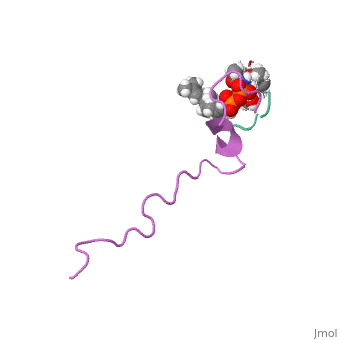Nisin
From Proteopedia
(Difference between revisions)
| Line 2: | Line 2: | ||
| - | <StructureSection load=' | + | <StructureSection load='1wco' size='340' side='right' caption='60/607847/Nisin_structure/4' scene=''> |
| - | + | <ref>PMID:21638687</ref> | |
| - | + | == Function == | |
| - | [[nisin]] is a polycylic | + | [[nisin]] is a polycylic antibacterial peptide, with 34 amino acid residues used as a food preservative. |
| - | Nisin is produced by fermentation using the bacterium Lactococcus lactis | + | Nisin is produced by fermentation using the bacterium ''Lactococcus lactis''. |
| - | While in general most [[bacteriocins]] inhibit only closely related species, nisin is a rare example of a "broad-spectrum" bacteriocin effective against many Gram-positive organisms, including lactic acid bacteria (commonly associated with spoilage), Listeria monocytogenes (a known pathogen), Staphylococcus aureus, Bacillus cereus, Clostridium botulinum, etc. It is also particularly effective against spores. Gram-negative bacteria are protected by their outer membrane but may become susceptible to nisin action after a heat shock or when this is coupled with the chelator EDTA. Nisin is soluble in water and can be effective at levels nearing the parts-per-billion range. | + | While in general most [[bacteriocins]] inhibit only closely related species, nisin is a rare example of a "broad-spectrum" bacteriocin effective against many Gram-positive organisms, including lactic acid bacteria (commonly associated with spoilage), ''Listeria monocytogenes'' (a known pathogen), ''Staphylococcus aureus,'' ''Bacillus cereus'', ''Clostridium botulinum'', etc. It is also particularly effective against spores. Gram-negative bacteria are protected by their outer membrane but may become susceptible to nisin action after a heat shock or when this is coupled with the chelator EDTA. Nisin is soluble in water and can be effective at levels nearing the parts-per-billion range. |
| - | + | ||
| - | + | ||
== Disease == | == Disease == | ||
== Relevance == | == Relevance == | ||
| + | |||
| + | In the food industry, it is obtained from the culturing of ''L. lactis'' on natural substrates, such as milk or dextrose, and is not chemically synthesized. | ||
== Structural highlights == | == Structural highlights == | ||
| Line 29: | Line 29: | ||
<scene name='60/607847/Spacefill/1'>Here</scene> you can see the peptid in a spacefill presentation. | <scene name='60/607847/Spacefill/1'>Here</scene> you can see the peptid in a spacefill presentation. | ||
</StructureSection> | </StructureSection> | ||
| + | == 3D structure of nisin == | ||
| + | |||
| + | [[1wco]] - Nisin + lipid - ''Lactococcus lactis'' - NMR<br /> | ||
== References == | == References == | ||
<references/> | <references/> | ||
Revision as of 08:59, 25 February 2016
Nisin
| |||||||||||
3D structure of nisin
1wco - Nisin + lipid - Lactococcus lactis - NMR
References
- ↑ Herraez A. Biomolecules in the computer: Jmol to the rescue. Biochem Mol Biol Educ. 2006 Jul;34(4):255-61. doi: 10.1002/bmb.2006.494034042644. PMID:21638687 doi:10.1002/bmb.2006.494034042644

